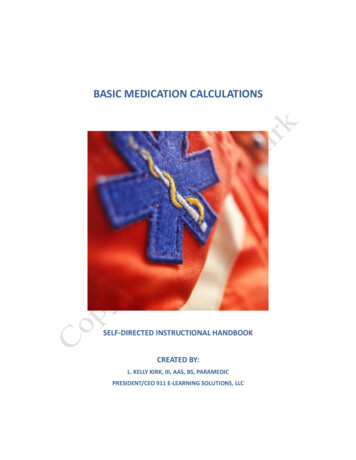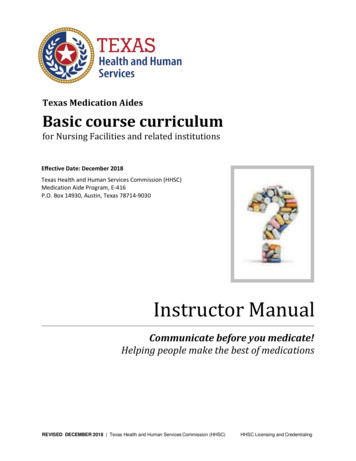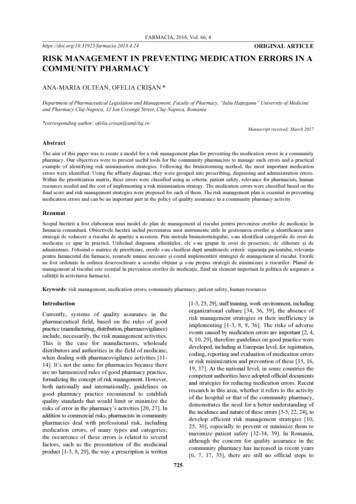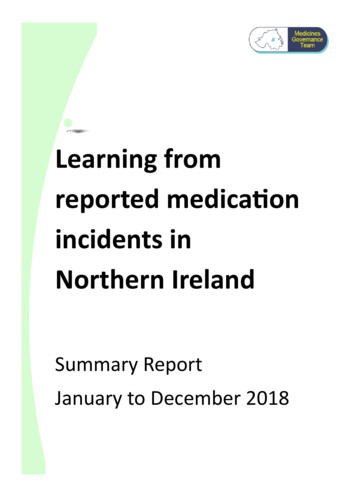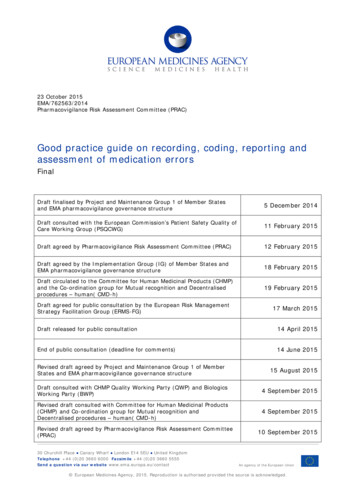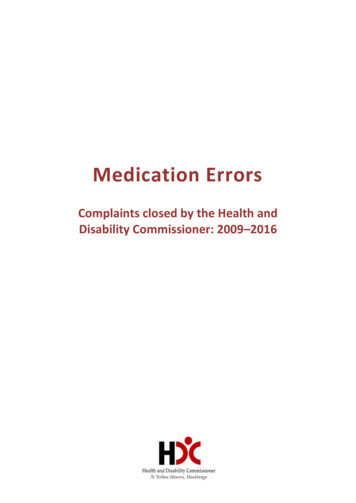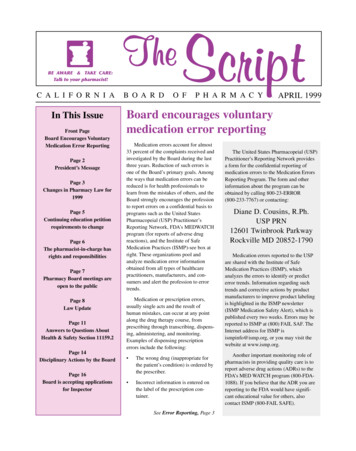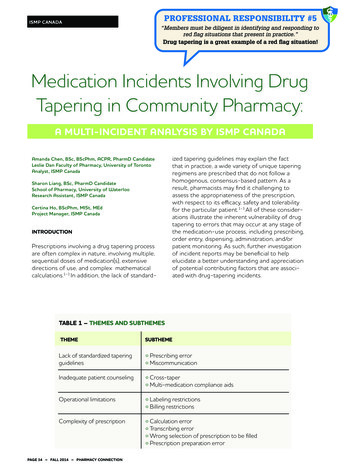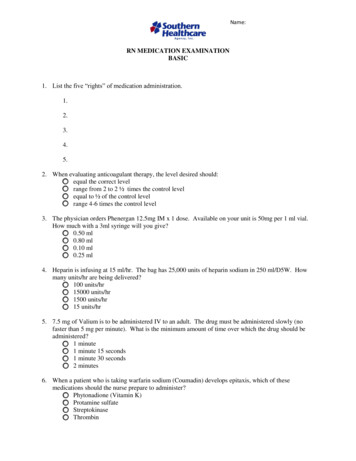
Transcription
Name:RN MEDICATION EXAMINATIONBASIC1. List the five “rights” of medication administration.1.2.3.4.5.2. When evaluating anticoagulant therapy, the level desired should:a. equal the correct levelb. range from 2 to 2 ½ times the control levelc. equal to ½ of the control leveld. range 4-6 times the control level3. The physician orders Phenergan 12.5mg IM x 1 dose. Available on your unit is 50mg per 1 ml vial.How much with a 3ml syringe will you give?a. 0.50 mlb. 0.80 mlc. 0.10 mld. 0.25 ml4. Heparin is infusing at 15 ml/hr. The bag has 25,000 units of heparin sodium in 250 ml/D5W. Howmany units/hr are being delivered?a. 100 units/hrb. 15000 units/hrc. 1500 units/hrd. 15 units/hr5. 7.5 mg of Valium is to be administered IV to an adult. The drug must be administered slowly (nofaster than 5 mg per minute). What is the minimum amount of time over which the drug should beadministered?a. 1 minuteb. 1 minute 15 secondsc. 1 minute 30 secondsd. 2 minutes6. When a patient who is taking warfarin sodium (Coumadin) develops epitaxis, which of thesemedications should the nurse prepare to administer?a. Phytonadione (Vitamin K)b. Protamine sulfatec. Streptokinased. Thrombin
7. Which of these mediations should the nurse have available to provide coverage for a patient who hasketoacidoisis?a. Glucagonb. Regular insulinc. NPH 70/30d. Glucophage8. A patient is scheduled to undergo bronchoscopy. The nurse will hold which of the followingmediations one week to 10 days prior to the procedure.a. Ibuprofen (Motrin)b. Atenolol (Tenormin)c. Omeprazole (Prilosec)d. Digoxin (Lanoxin)9. Side effects of nitroglycerin (Nitrostat) include:a. tremors and dyspepsiab. papillary constriction and diarrheac. dry mouth and bradycardiad. hypotension and flushing10. You need to infuse 500 ml of NS over 8 hours. What will you set your IV pump to deliver in ml/hr?a. 61 ml/hrb. 63 ml/hrc. 65 ml/hrd. 75 ml/hr11. Narcan (Naloxone) is used to reverse the effects of what class of medication?a. NSAIDSb. Benzodiazepenesc. Beta Blockersd. Opiods12. A patient is to receive Meperidine Hydrochloride 75 mg and Atropine Sulfate 0.3 mg IMpreoperatively. Meperidine is available in a syringe containing 100 mg per ml. Atropine is availablein a vial containing 0.4 mg per ml. If the two drugs were combined in the same syringe foradministration, how many milliliters would be given?a. 1.05 mlb. 1.5 mlc. 2 mld. 1.2 ml13. A patient is to receive 20 units of NPH insulin and 10 units of Regular insulin as an injection. Howshould the patient be taught to prepare the insulin for injection?a. Draw up each insulin in a separate syringe.b. Withdraw NPH insulin first then draw up the Regular insulin in the same syringe.c. Withdraw the Regular insulin first and then draw up the NPH in the same syringe.14. A patient who is taking Tylenol should be observed for signs of toxic reaction, which include:a. hearing lossb. vascular changesc. gastric ulcersd. liver damage
15. When administering eye drops to a patient, the nurse should place the medication in the lowerconjunctival sac to:a. reduce the systemic absorption of the medicationb. increase the circulation to the areac. prevent injury to the cornead. to prevent tear duct absorption
Name:RN EXAMINATIONPEDSIf you work in PEDS, please answer the following questions.1. A 5 month-old infant is brought to the clinic by his mother, who reports that the infant has nasalcongestion, symptoms of a cold, fever, and difficulty breathing. The nurse should first:a.b.c.d.ask for more history.perform a respiratory assessment.notify the available physician.take vital signs.2. You arrive in a patient room of a 10-year-old child who suddenly collapsed in his room. Thechild is unresponsive, apneic, and pulseless and CPR is in progress. A co-worker has provided anAED, turned it on, and attached it. The AED recommends a shock. Which of the followingshould be done next?a.b.c.d.obtain IV accessattempt defibrillationchange compression:ventilation rate from 30:2 to 15:2.attempt endotracheal intubation.3. Pavulon (pancuronium bromide) is ordered for a 7 kg intubated infant. The order reads "0.1 - 0.2mg/kg per dose PRN movement”. What is the correct dosage range for this client?a.b.c.d.1-2 mg1.4 mg0.7 -1.4 mg0.7 mg4. Young children are at risk of sustaining a cervical spine injury because:a.b.c.d.their heads are smaller in proportion to the rest of their body surface areatheir neck muscles are still undeveloped and initially are stiff.their injuries do not show up on regular x-ray films.their heads are the largest part of their bodies.5. You are in the clinic, and a mother walks in carrying her limp infant in her arms. She says, “Ithink he stopped breathing on the way here.” What should be your first step in the BLS sequenceof action?a.b.c.d.check for breathingcheck for signs of circulationcheck for responsivenessopen the airway.
Name:RN EXAMINATIONPediatric Intensive Care UnitIf you work in PICU, please answer the following questions.1.What are the treatment options for junctional tachycardia?a. Pacingb. Antiarrhythmicsc. Treatment of underlying conditionsd. All of the above2.A 3-year-old boy was found with an open bottle of his mother’s prenatal vitamins with iron. Thecolor of the tablet coating is seen inside the child’s mouth. Twenty-five tablets are uncounted for.Following ingestion of iron, gastrointestinal (GI) decontamination may include all of the following,except:a. Ipecac syrupb. Gastric lavagec. Activated Charcoald. Whole Bowel Irrigation3.A 10 month old, Sara is admitted to the PICU with acute mental status changes. One of Sara’ssiblings died of suspected liver failure. Sara’s lab results are as follows: bilirubin 5.2 mg/dl, AST4268 IU/L, ammonia 220 mcmo/L, albumin 3.2 g/dl, platelets 180,000/mm3, WBC 8.2 x109/L andPT 33 seconds. She is on 0.5L of 0xygen per nasal canula, is lethargic and does not respond tostimuli. Which of the following would you observe?a. Jaundiceb. Petechiaec. Erythematous diffuse rashd. Cyanosis4. Rob, a 13 year-old boy with a history of leukemia, received a bone marrow transplant 80 days ago.He was admitted to the ICU in septic shock. Which of the following indicate an attempt by thekidneys to compensate for the changes in the child’s condition?a. Increased serum bicarbonate, vasoconstriction of arterioles, secretion of renninb. Decreased serum bicarb, vasoconstriction of arterioles, secretion of renninc. Increased sodium excretion, vasodilation of arterioles, secretion of rennind. Increased sodium reabsorption, vasodilation of arterioles, secretion of rennin5. On day 2, Rob’s blood urea nitrogen (BUN) increased to 75 mg/dl, and the creatinine remained at2.4 mg/dl. The increase in BUN may be an indication of worsening acute renal failure (ARF) andacute tubular necrosis (ATN).a. Trueb. False6.Most pediatric burns occur in:a. Newbornsb. Infants and toddlersc. School-age childrend. Adolescent
7. Jennifer has a positive Brudzinski sign, which is best described as:a. Extension of upper and lower extremitiesb. Pupil constriction with neck flexionc. Back pain and resistance after passive extension of lower legsd. Flexion of hip and knees after passive flexion of the neck8. Which diagnostic test is most definitive for RSV bronchiolitis?a. Chest x-rayb. Pulse oximetryc. Fluorescent antibody testd. Arterial blood gas analysis9. A 3 month old is admitted to the PICU for respiratory compromise secondary to ascites andhepatosplenomegaly. The child is on oxygen per nasal cannula and is started on aggressive diuretictherapy.What is the most likely diagnosis for this infant?a. Tylenol overdoseb. Biliary atresiac. Wilson’s diseased. Hepatocellular carcinoma10. What is the etiology of the ascites and hepatosplenomegaly?a. Portal hypertensionb. Hepatic encephalopathyc. Jaundiced. Coagulopathy
Name:RN EXAMINATIONCritical Care UnitIf you work in CCU/ICU, please answer the following questions.Questions 1 and 2 refer to the following scenario.A 63-year-old male is admitted to your unit with an anterior wall MI (myocardial infarction). His bloodpressure is 92/56 with a heart rate of 102. During your discussion with the physician, the question arisesof whether treatment to increase the blood pressure should be started. One drug suggested is dopamine.1.What would be the effect of adding a vasopressor such as dopamine?a. increase systemic vascular resistance and myocardial oxygen consumptionb. decrease CVP (central venous pressure) and myocardial oxygen consumptionc. increase PAOP (pulmonary artery opening pressure) and decrease myocardial oxygenconsumptiond. increase cardiac output and decrease PAOP2. How would you make a determination of whether the blood pressure is low enough to be of clinicalconcern?a. assess the cardiac output and measure blood gases for a PaO2 valueb. assess the cardiac output and assess level of consciousnessc. measure blood gases for a PaO2 value and assess level of consciousnessd. all of the aboveQuestions 3 and 4 refer to the following scenario.A 32-year-old female is admitted to your unit following a house fire in which she was rescued after losingconsciousness. She has a 30% burn, with most of the burns on her back and legs.3. Upon admission to the unit, which therapies are most likely to be initiated?a. conservative fluid resuscitationb. topical antimicrobial agents (e.g., silver sulfadiazine, Silvadene)c. occlusive dry dressingsd. sedation and paralysis4. Which test would be performed to assess the extent of her smoke inhalation?a. chest roentgenographyb. measurement of carboxyhemoglobin levelc. arterial blood gas analysisd. ventilation/perfusion lung scan5. Following an angioplasty, a 55-year-old male returns to the critical care unit. Which of the followingmeasures would be expected to be performed in the next 8 hr?a. sitting him up in the chair after 4 hrb. intermittent pressure over the insertion sitec. monitoring for reperfusion dysrhythmiasd. protomine sulfate infusions6. Dopamine is infusing at 15 ml/hr. The concentration is 200 mg dopamine/250 ml of D5W. Theclient weighs 145 pounds. How many mcg/kg/min is being delivered?a. 6.04b. 3.03c. 4.06d. 1.03
7. Natrecor (Nesiritide) is human B-type natriuretic peptide (hBNP) and is used to decrease PCWP andarterial pressure in symptomatic patients with decompensated congestive heart failure. Weight basedIV administration of Natrecor relaxes arterial and venous smooth muscle. All of the followingstatements are true except:a. administer with caution in Renal patientsb. Natrecor may cause dizziness and lightheadednessc. Natrecor is a first line drug for cardiogenic shockd. Natrecor is contraindicated for patients with valvular stenosis and constrictive pericarditis8. You are going to start a Levophed infusion. The pharmacy mixes your infusion 16 mg into 250 cc ofD5W. What is your mcg per ml concentration?a. 160 mcg/mlb. 32 mcg/mlc. 64 mcg/mld. 128 mcg/ml9. Romazicon (Flumazenil) is used to reverse what the effects of what class of drug?a. NSAIDSb. Benzodiazepenesc. Opiodsd. Cholinergics10. What is the antidote for Heparin Sodium?a. Protamine Sulfateb. Cholecalciferolc. Histrelin Acetated. Terbutaline Sulfate11. Increased secretions and mucous plugging will potentially result in which clinical condition?a. congestive heart failureb. atelectasisc. increased physiologic dead spaced. chronic lung diseaseQuestions 12 and 13 refer to the following scenario.A 61-year-old female is admitted to your unit at 1500 after repair of an abdominal aortic aneurysm. Heradmission vital signs and hemodynamics are stable and within normal limits. At 2000, she complains ofabdominal discomfort unrelated to incisional pain. Her breath sounds are clear, her skin is cool, and shehas no shortness of breath. The following hemodynamic information is available:blood pressure100/60pulse112PA23/10PAOP6CVP2cardiac output3.6cardiac index2.012. Based on the preceding information, which condition is likely to be developing?a. left ventricular failureb. hypovolemiac. sepsisd. cardiogenic shock
13. Which initial treatment would best support her hemodynamic function?a. Furosemide (Lasix)b. Dobutaminec. Normal saline bolusd. DopamineQuestions 14 and 15 refer to the following scenario.A 78-year-old female is in the unit following a change in level of consciousness. Her head CT scandemonstrates a large subdural bleed. This is her third day in the unit. Presently, she is responsive only topainful stimuli. Her current vital signs and laboratory data are as follows:blood pressure144/84pulse85respiratory rate21temperature37.4intake3100output6340urinary osmolality288serum osmolality324Na 15214. Based on the above information, what condition is likely developing?a. SIADH (syndrome of inappropriate secretion of the antidiuretic hormone)b. myxedema comac. hyperthyroidismd. diabetes insipidus15. Which of the following is most likely effective treatment for the above condition?a. DDAVP (desmopressin acetate)b. thyroxinec. 500 ml of D5Wd. propylthiouracil
Name:RN EXAMINATIONOncologyIf you work in Oncology, please answer the following questions.1. In a patient with bone metastases, which of the following symptoms should alert the nurse to thepresence of hypercalcemia?a. Muscle Crampsb. Edemac. Dyspnead. Polyuria2. Successful management of diarrhea induced by treatments that alter mucosa and bowel motilityshould include medication to:a. suppress the inflammatory response.b. alter the absorption of nutrients from the bowel.c. stimulate the absorption of excess fluid from the bowel.d. reduce peristalsis or soothe the bowel lining.3. Liver metastasis most often results from which of the following modes of metastatic spread?a. Hematogenicb. Lymphogenicc. Contactd. Transcavitary seeding4. Which of the following statements about the preparation of antineoplastic agents is true?a. Sterile technique is not required in the preparation of IV antineoplastics because of theirlethal effect on tumor cells.b. Intravenous antineoplastics are best prepared and dispensed by the same procedures as anyother IV admixture.c. Only specially trained physicians, nurses, and pharmacists should prepare antineoplastics foradministration.d. In reconstituting antineoplastics, positive pressure must be used to inject the diluents into thevial.5. On the first postoperative day following a modified radical mastectomy, a patient should beencouraged to:a. keep her affected arm in a sling and avoid all exercise.b. perform exercises with wrist and elbow flexion and extension.c. perform passive range-of-motion exercises of the elbow and shoulder.d. perform active range-of-motion exercises of the elbow and shoulder.6. A patient who is to receive a radioactive implant asks why her room is at the far end of the hall. Thenurse’s best response would be which of the following?a. “Patients requiring the least amount of physical care are in rooms farthest from the nurses’station.”b. “An end room provides the most sunlight and least distraction during your stay in thehospital.”c. “This location provides the least radiation exposure to hospital staff and other patients.”d. “This location protects those nurses who may be pregnant and working in this unit.”
7. A nurse can best demonstrate the philosophy of patient advocacy by doing which of the following?a. Determining the priorities for the patient’s plan of careb. Supporting the patient’s right to make decisions about carec. Sharing individual values with the patient in developing the plan of cared. Explaining the physician’s plans to the patient and family8. A 65-year-old patient has had a surgical resection for adenocarcinoma of the colon. As a result, he hasa permanent colostomy located proximally in his ascending colon, which he refuses to look at. Thenurses who is caring for him on his first postoperative day should be concerned primarily with his:a. status regarding dehydration and hypokkalemia.b. total fat intake.c. knowledge of how to care for the colostomy.d. refusal to look at the colostomy.9. Which of the following is a voluntary public service organization that would be most likely toprovide transportation for a person with cancer who needs daily radiation treatments?a. American Automobile Associationb. American Red Crossc. National Hospice Organizationd. American Cancer Society10. Assessment for suspected bladder cancer should include evaluation for:a. hematuria.b. abdominal distention.c. flank pain.d. fever.11. A patient who has just completed treatment for cancer wants to return to her job in the aerospaceindustry. Her employer tells her that she cannot have her job back because she has had cancer. Heremployer’s action is violating which of the following?a. The Federal Rehabilitation Act of 1973b. The National Cancer Act of 1971c. Current American Cancer Society guidelinesd. Occupational Safety and Health Administration (OSHA) guidelines12. A patient had a radical hysterectomy and bilateral pelvic lymphadenectomy yesterday. She asked thereason for her suprapubic catheter. The nurse’s best response is which of the following?a. “Your bladder may not work for a while because of irritation of the nerves.”b. “The tube is for collecting the urine so you won’t be bothered with urinating.”c. “There are many nerves there and they may have been injured during the surgery. The tubewill facilitate draining of the urine if any damage occurred.”d. “Your bladder needs to rest for a while after surgery.”
IV administration of Natrecor relaxes arterial and venous smooth muscle. All of the following statements are true except: a. administer with caution in Renal patients b. Natrecor may cause dizziness and lightheadedness c. Natrecor is a first line drug for cardiogenic shock d.File Size: 1MB
